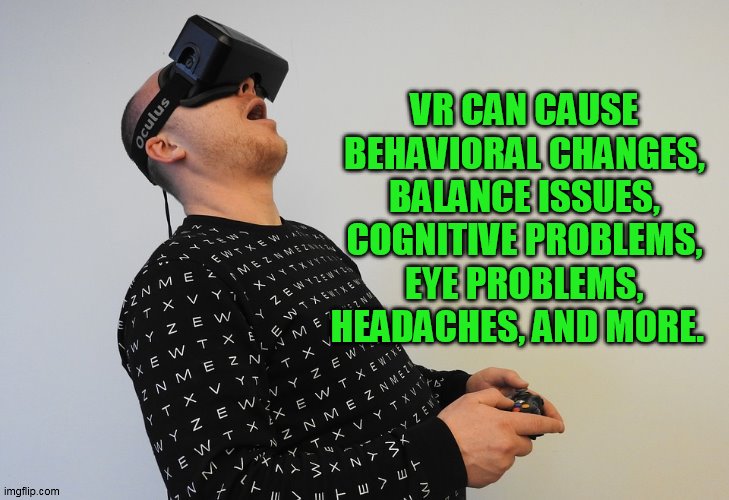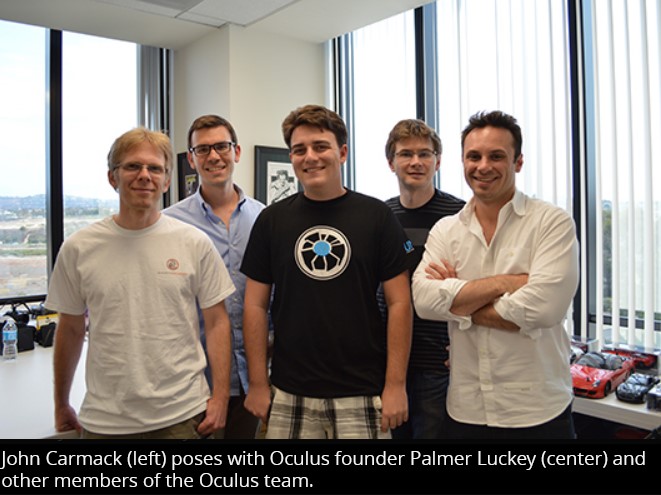 By B.N. Frank
By B.N. Frank
Virtual reality (VR), augmented reality (AR), and mixed-reality (MR) systems are increasingly being manufactured and marketed for use by adults as well as children for a variety of purposes despite research confirming that they are harmful to our behavioral, emotional, mental, and physical health. In fact, last month a report from the Department of Defense (DoD) confirmed that that 80% of the soldiers who used Microsoft HoloLens mixed-reality headsets experienced “mission-affecting physical impairments”. In other horrifying news, a former Oculus employee has deliberately designed a new user-killing VR headset. As if Oculus VR systems aren’t already awful enough.
From Ars Technica:
A new kind of “killer app” —
Oculus co-founder makes a VR headset that can literally kill you
Sword Art Online inspires Palmer Luckey to put explosive charges on a Quest Pro.
The idea that dying in a video game or simulation could cause your death in real life is a common trope that has appeared in dozens of fictional works in recent decades. Now, though, Oculus co-founder Palmer Luckey has made the concept real.
On his personal blog, Luckey writes of a new VR headset he has designed that uses three embedded explosive charges, planted above the forehead, that can “instantly destroy the brain of the user.” The lethal explosion is triggered via “a narrow-band photosensor that can detect when the screen flashes red at a specific frequency,” Luckey writes, making it easy to set off during a “Game Over” screen.
To be clear, Luckey says his deadly headset—which looks in images like a modified Meta Quest Pro—is “at this point… just a piece of office art, a thought-provoking reminder of unexplored avenues in game design.” At the same time, though, Luckey writes that “the idea of tying your real life to your virtual avatar has always fascinated me—you instantly raise the stakes to the maximum level and force people to fundamentally rethink how they interact with the virtual world and the players inside it.”
Luckey ties this fascination to Sword Art Online (SAO), a series of Japanese novels (and spinoff anime, video games, etc.) about a virtual reality MMORPG with the same name. In that fiction, November 6, 2022, marks the day when thousands of SAO players are trapped in their NerveGear headsets and threatened with death via a hidden microwave generator if they die in the game (or if they try to remove or tamper with the headset).
Further Reading Oculus Rift head-mounted display finds funding from developers
The Sword Art Online anime was just airing when the first Oculus Rift Development Kit launched on Kickstarter back in 2012, helping to drive what Luckey calls “massive otaku enthusiasm for Oculus, especially in Japan, which quickly became our 2nd largest market.” He says that “literally thousands” of fans have reached out to him over the year about Sword Art Online, asking, “When will you make the NerveGear [headset] real?!”
A history of consequences
More than realistic graphics, Luckey writes that “only the threat of serious consequences can make a game feel real to you.” He likens such consequences to a “long history of real-world sports revolving around similar stakes,” though it’s important to remember that most sports injuries fall well short of instant death.
But while Luckey writes that this is “an area of video game mechanics that has never been explored,” that’s not strictly true. Back in 2001, the PainStation art installation threatened players who lost a game of Pong with “sensations such as heat, punches and electroshocks of varying duration,” as Wired described it. That same year, the “Tekken Torture Tournament” provided a fighting game competition in which “32 willing participants received bracing but non-lethal electrical shocks in correspondence to the injuries sustained by their onscreen avatars.”
On the other end of the simulated pain equation, last year the Food and Drug Administration approved a virtual reality pain management system that uses “established principles of behavioral therapy intended to address the physiological symptoms of pain and aid in pain relief through a skills-based treatment program.”
Further Reading Oculus cofounder Palmer Luckey leaves Facebook
In any case, Luckey cites “a huge variety of failures that could occur and kill the user at the wrong time” in explaining why he has “not worked up the balls to actually use” his deadly new headset. Still, the project shows that Luckey still harbors a deep interest in virtual reality more than five years after he was fired by Oculus parent company Facebook (now Meta) amid controversy over political donations.
In the years since, Luckey’s professional life has been largely focused on his military tech startup Anduril. In an April personal blog post, though, he wrote that the year of the 10th anniversary of Oculus’ founding was “the right time to finally unveil some VR technologies I haven’t been able to talk about for a variety of reasons.”
We’re guessing this deadly headset wasn’t what he meant by that, but it’s hard to know for sure…
Activist Post reports regularly about AR, MR, VR, and other unsafe technology. For more information, visit our archives and the following websites:
- Environmental Health Trust
- Electromagnetic Radiation Safety
- Physicians for Safe Technology
- Wireless Information Network
Become a Patron!
Or support us at SubscribeStar
Donate cryptocurrency HERE
Subscribe to Activist Post for truth, peace, and freedom news. Follow us on SoMee, Telegram, HIVE, Flote, Minds, MeWe, Twitter, Gab, What Really Happened and GETTR.
Provide, Protect and Profit from what’s coming! Get a free issue of Counter Markets today.




Be the first to comment on "New VR Headset Can “instantly destroy the brain of the user”"